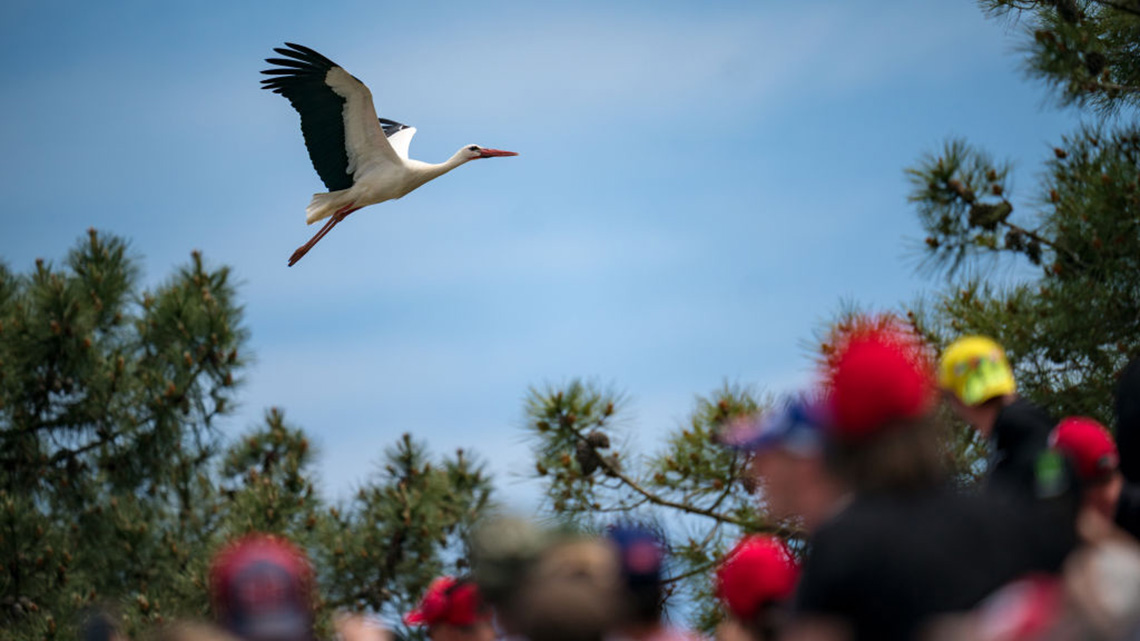Minds On
How does it fly?

Do you know what it takes to make something fly?
Regardless of the animal, insect, object or item that’s flying, forces of flight are what affect something’s ability to fly.
Explore the following Science North video clip to learn more about the forces of flight.
Brainstorm
Brainstorm
Let’s brainstorm about the following questions:
- How many animals, insects, objects, or flying devices can you list?
- Do you know what it takes for something to be able to fly?
- Do you know what the four forces involved in flight are called?
Record your ideas in a notebook or another method of your choice.
If possible, share your thoughts with a partner.
Action
Future impacts
This learning activity connects new and existing approaches for young scientists to create positive changes in their communities.

The forces of flight
Regardless of the animal, insect, object or flying device, there are four forces that make flight possible:
- Weight is the force that pulls the flying object or device down.
- Lift is the force that raises the flying object or device up.
- Drag is the force that pulls the flying object or device backwards.
- Thrust is the force that pushes the flying object or device forward.
All four forces act on the airplane at once and in equal and opposite directions.

Forces of flight
An airplane diagram with labels of the four forces of flight. On the bottom of the plane, there is an arrow pointing down to show the force of weight pulling the plane down. Over the top of the airplane, an arrow points up to show the force of lift, raising the plane up. At the plane’s nose or tip, an arrow points in a forward direction for the force of thrust, so pushing the airplane forward. At the plane’s tail, an arrow points in a backwards direction, showing the force of drag pulling the plane backwards.
How do they work?
Check out the following Science North video clip to learn more about each force of flight and how they work.
Student Success
Your turn!
Using the information you have learned so far about the four forces of flight, create your own detailed diagram that shows how the forces of flight apply to an airplane. Be sure to include an explanation of what each force is!
Then, create a second diagram that shows the forces of flight as they apply to a drone.
Lastly, reflect on the differences and similarities between the forces of flight acting on an airplane versus a drone.
Record your thoughts, ideas, and diagrams in a notebook or using another method of your choice.
Rockets

Let’s explore how the forces of flight apply to a real-life example of a flying machine!
Throughout the 1900s, scientists were able to enhance a technology called rockets that were powerful enough to propel large, human-made objects and travel fast enough to escape the pull of Earth’s gravity.
Rockets have been used to send satellites and other space technology, as well as astronauts up into space. Rocket technology was made possible because scientists understood how to modify the forces of flight.
Check out the following rocket to explore how the four forces of flight support its ability to fly.

A rocket demonstrating the four forces of flight. The rocket is a long tube with a pointed tip and two fins on the other end. There is fire coming out of the bottom end. The rocket is flying upward. The part near the bottom of the rocket is labelled lift. There is an arrow pointing downward from the rocket labelled drag. The body of the rocket is labelled weight. There is an arrow pointing upward from the bottom of the image to the bottom of the rocket. This arrow is labelled thrust.
Press the following tabs to access how a rocket uses each force of flight.
A rocket burns fuel to produce really hot gas, which shoots backward out of the end of it, providing thrust. Thrust pushes the rocket off the ground and allows it to keep moving forward and stay in flight. This action is called jet propulsion.
The thrust from jet propulsion is needed to overcome the drag from the Earth’s atmosphere. Drag is what slows flying objects down.
Given the size, materials they are made of, and the loads that rockets and spacecrafts often carry, they also involve a significant amount of weight.
Weight is the force of gravity pulling an object to the centre of large objects, like the centre of Earth.
To counteract the substantial weight, rockets use wing-like add-ons to provide lift, a force that allows objects to rise up.
In action…
To explore these forces in action, access the following video clip, which is the 2008 launch of the space shuttle, Endeavour, from NASA’s Kennedy Space Centre in Florida, USA.
When space shuttles are ready to return to Earth, they rely on different forces of flight to make a safe re-entry through Earth’s atmosphere and a safe landing back on the ground.
Access the following video clip to learn more about a space shuttle’s landing.
Brainstorm
Brainstorm
Let’s brainstorm about the following:
- What parts of the space shuttle do you think helped it to land safely?
- Which forces were being used to allow the safe landing to happen?
Record your ideas in a notebook or another method of your choice.
If possible, share your thinking with a partner.
Press ‘Hint’ to access a detail.
What popped out from the back of the space shuttle as it touched the ground, and what was it for?
When you’re ready, press ‘Let’s Check!’ to access the correct response.
It was a parachute!
A parachute is needed to increase drag. Due to the very high speed at which the space shuttle was travelling when it landed, the parachute slows it down very quickly to a point where it can safely slow down, and eventually stop.
But that’s not the only part that helps the shuttle land! The weight of the shuttle and the wings both play a very important part.
Let’s investigate!
A great and fairly easy way for us citizen scientists to explore and manipulate the forces of flight for ourselves is with paper airplanes!
Check out the following video entitled “Air and Flight” to learn more about the forces of flight in a paper airplane.
Now, it’s your turn to be citizen scientist and investigate the forces of flight in action!
Paper planes
- Can you create a paper airplane using only one sheet of uncut paper?
- How far can you get it to glide?
As you explore the following Science North video clip, think about what allows flight to be possible.
Now, let’s use the Engineering Design Process!
Explore this video to learn about the steps of the Engineering Design Process.
Always be sure to do your safety checks before any experiment or investigation task!
Press the following tabs to access details about this task.
You will need:
- four sheets of paper
Your task is to use only one sheet of paper at a time to fold at least four different paper airplane styles or variations.
The goal is to design a plane that flies a far distance with the most consistent flight path (as straight and steady as possible)!
Review the following tips to fly your planes safely, and to keep yourself safe!
- Be cautious of your environment and surroundings.
- Try to not hit anything fragile around you.
- If possible, consider doing this activity in a wide-open space.
- When testing your planes, fly the planes from a safe height.
While testing your paper planes and their flight attempts, be sure to record all details in the following organizer or another method of your choice.
You may also include any changes that you make to the plane’s design in between flight trials.
Complete the Paper Airplane Trials Activity in your notebook or using the following fillable and printable document. If you would like, you can use speech-to-text or audio recording tools to record your thoughts.

Press the Activity button to access the Paper Airplane Trials Activity.
Activity (Open PDF in a new tab)Pause and Reflect
Pause and reflect
- Which of your four designs flew the farthest and with the straightest flight path?
- What about its design do you think allowed it to travel farther than your other paper planes?
Record your thinking in a notebook or another method of your choice.
Pause and Reflect
Pause and reflect
- Were you able to successfully launch, fly, and land your UAV?
- How many design attempts did it take for you to get off the ground and then fly your UAV to its destination?
Record your thinking in a notebook or another method of your choice.
Consolidation
Learning check!

Let’s review what we have learned throughout this learning activity.
For each sentence, select the missing word from the drop-down menu.
Analyzing results
For this activity, consider your explorations from the Action section. Then, make connections between what you observed or experienced and the four forces involved in flight:
- weight
- lift
- drag
- thrust
Pause and Reflect
Pause and reflect
- What were some overall observations or findings from the paper plane trial attempts and/or your experience with the flight game?
- What conclusions can you make about the forces of flight? What are they? How did they work?
Record your ideas in a notebook or another method of your choice.
Press ‘Hint’ to access a detail.
You may use your paper plane designs or game experience to explain your thinking.
Reflect on the different changes you made to your designs, and how it affected the forces of flight.
Create diagrams if needed to explain your thoughts.
Reflection
As you read through these descriptions, which sentence best describes how you are feeling about your understanding of this learning activity? Press the button that is beside this sentence.
I feel…
Now, record your ideas using a voice recorder, speech-to-text, or writing tool.
Press ‘Discover More’ to extend your skills.
Discover MoreMaking connections
Summarize your learning with the following questions:
- Why can’t a glider keep flying?
- Why does it always eventually land?
Be sure to reflect on the forces of flight in your response.
Record your ideas in a notebook or another method of your choice.